ISSN ONLINE(2319-8753)PRINT(2347-6710)
ISSN ONLINE(2319-8753)PRINT(2347-6710)
D.DivyaTeja1, M.Bhavani 2, V.Sridevi 3*, P.Snehalatha4, and M. Lohita5
|
| Related article at Pubmed, Scholar Google |
Visit for more related articles at International Journal of Innovative Research in Science, Engineering and Technology
Biosorption is the adhesion of molecules of gas, liquid, or dissolved solids to a surface. Adsorption is present in many natural physical, biological, and chemical systems and is widely used in industrial applications. Here we had been reported work on removal of dyes from waste water by using papaya peel as biosorbent and experimental data were obtained for removal of Methylene blue dye. The results of the present work indicate that the papaya peel can be used as adsorbent for the efficient removal of Methylene blue. Since the papaya peel is easily and cheaply available in almost every places, its application for colour removal could be expected to be a practical proposition. The dye removal performance was strongly affected by parameters such as agitation time, methylene blue concentration, biosorbent dosage, pH, and temperature. The effective time of contact for better dye removal performance was found to be 35 min and dye concentration of 1mg/100ml . Maximum removal of dye was achieved at the adsorbent dosage of 0.3g/100ml and at pH 8 and at temperature 350 C. The sorption of methylene blue on papaya peel was found to follow Langmiuer- Freundlich isotherm, suggesting the possibility of heterogeneous distribution of active sites on the surface of the sorbent and the second order kinetics was best fit.
Keywords |
| Methylene blue, papaya peel, biosorption, initial concentration, pH, biosorbent dosage, agitation time, temperature, Langmiuer and Freundlich isotherm |
INTRODUCTION |
| Dyes usually have complex aromatic molecular structures which make them more stable and difficult to biodegrade[2]. Furthermore, many dyes are toxic to some microorganisms and may cause direct destruction or inhibition of their catalytic capabilities. Organic dyes are an integral part of many industrial effluents and demand an appropriate method to dispose them off. There are numerous techniques of dye removal. There are various conventional methods of removing dyes including coagulation and flocculation, oxidation or ozonation and membrane separation. Activated carbon is widely used as an adsorbent due to its high adsorption capacity, high surface area, micro porous structure, and high degree of surface respectively[4]. These are expensive and major cost is associated with the dependence on imported technologies and chemicals. The indigenous production of treatment techniques and chemicals locally, or use locally available non-conventional materials to treat pollutants seems to be the solution to the increasing problem of treatment of effluents. Biosorption is the adhesion of molecules of gas, liquid, or dissolved solids to a surface. This process creates a film of the biosorbate (the molecules or atoms being accumulated) on the surface of the adsorbent. Similar to surface tension, adsorption is a consequence of surface energy [6]. In a bulk material, all the bonding requirements (be they ionic, covalent, or metallic) of the constituent atoms of the material are filled by other atoms in the material. |
| Adsorption Isotherms: Langmuir isotherm: The Langmuir isotherm has been successfully applied to many pollutant adsorption processes and has been the most widely used adsorption isotherm for the adsorption of a solute from a liquid solution. A basic assumption of the Langmuir theory is that adsorption takes place at specific homogeneous sites within the adsorbent. It is then assumed that once a dye particle occupies a site, no further adsorption can take place at that site. The rate of adsorption to the surface should be proportional to a driving force, which times an area. The driving force is the concentration in the solution, and the area is the amount of bare surface[9]. If the fraction of covered surface is f, the rate per unit of surface is: |
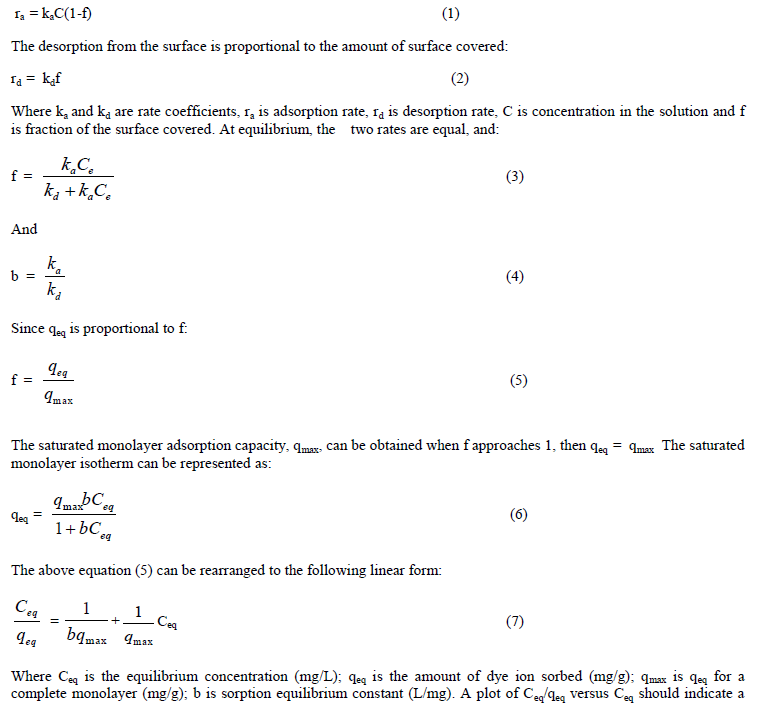 |
| straight line of slope 1/qmax and an intercept of 1/bqmax [8]. The results of this application present experiment were presented in figure-6. Freundlich isotherm: In 1906, Freundlich studied the sorption of a material onto animal charcoal. He found that if the concentration of solute in the solution at equilibrium, Ceq, was raised to the power m, the amount of solute adsorbed being qeq, then Ceq m /qeq was a constant at a given temperature [3]. This fairly satisfactory empirical isotherm can be used for non-ideal sorption and is expressed by the following equation: |
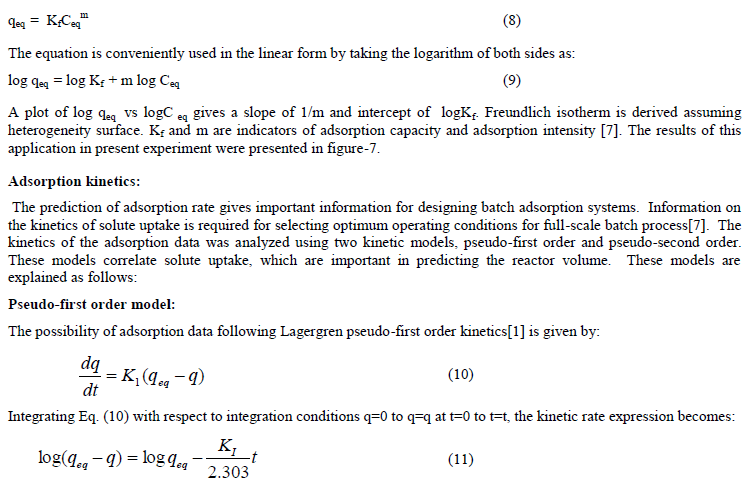 |
| In order to obtain the rate constant, the straight-line plot of log (qeq-q) versus time (t) was made for papaya peel for initial MB concentration 1mg/100ml-2m/100ml. The intercept of the above plot should equal to log qeq. However, if qeq from intercept does not equal to the equilibrium MB dye uptake then the reaction is not likely to be first order, even this plot has high correlation coefficient with the experimental data. It is observed that of Pseudo-firstorder is fit for this experiment. The results of this application in present experiment were presented in figure-8. Pseudo-second order model: A pseudo-second order model proposed by Ho and McKay was used to explain the sorption kinetics[1]. This model is based on the assumption that the adsorption follows second order chemisorptions[3]. The pseudo-second order model can be expressed as |
 |
| Where t is the contact time (min), qeq (mg/g) and q (mg/g) are the amount of dye adsorbed at equilibrium and at any time, t. If second order kinetics is applicable, the plot of t/q versus time should give a linear relationship from which the constants qeq and K2 can be determined. The results of this application in present experiment were presented in figure-9. The rate constants and the correlation coefficients of MB and for both tested models have been calculated and summarized in the Table-1. |
II. MATERIALS AND METHODS |
| Preparation of biomass/ adsorbent (Papaya peel): Papaya peels were used for the sorption of methylene blue. The Papaya peels was first cut into small pieces, extensively washed with tap water to remove adhering dirt and soluble components such as tannins, resins, reducing Sugar and colouring agents, and then oven dried at 800C .The washed and dried material was crushed and sieved to obtain different particle sizes. Preparation of dye solutions: Methylene blue, (MB) a cationic dye. The stock solutions at the desired concentrations were prepared with distilled water. The pH values of dye Solutions were adjusted with 0.001 N NaOH or HCl solutions using a pH meter. Batch Biosorption equilibrium experiments were carried out in 250ml stoppered conical flask at a constant agitation speed. All the experiments were at room temperature. The concentrations of dye solutions before and after sorption were determined using UV spectrophotometer by monitoring the absorbance for the dye used. Analysis of the sample: The total dye concentration in solution was analyzed with Spectrophotometer at a wavelength of 663 nm for MB solution. |
III. RESULTS AND DISCUSSIONS |
| `Experimental parameters: Effect of agitation time: Methylene blue solution was prepared with a concentration (1mg/100ml), adsorbent dosage (0.4g/100ml). Samples were withdrawn at 5min interval for estimating methylene blue concentration using spectrophotometer at the wavelength corresponding to maximum absorbance, λmax , of 663nm[6]. From the results shown in Figure 1, it was evident that percentage removal of methylene blue remains constant from the time beyond 35 minutes. Hence all the subsequent runs were confined to this time limit. Effect of methylene blue concentration: The methylene concentration varied from 1.0-2.0mg/100ml at a fixed adsorbent dosage of 0.4g/100ml[5]. By estimating methylene blue concentration using spectrophotometer at the wavelength corresponding to maximum absorbance, λmax , of 663nm. The results were presented in Figure 2, from which it is obvious that at lower initial concentrations, percent removal of the dye is higher. |
| Effect of adsorbent dosage: The effect of papaya peel dose on the biosorption of methylene blue was studied by using dye concentration of 1mg/100ml, by varying the biosorbent dosage in the range of 0.1-0.6g/100ml. Maximum removal of methylene blue took place at 0.3g/100ml. The results are presented in Figure 3. Effect of pH: The uptake of methylene blue by papaya peel were studied in a range of 2-12 for pH[5] by maintaining initial dye concentration of 1mg/100ml , biosorbent dosage of 0.3g/100ml solution, and a period of 35min. Maximum removal of methylene blue took place at a pH of 8. The results are presented in Figure 4. ` Effect of temperature: Methylene blue solution was prepared with a concentration (1mg/100ml), adsorbent dosage (0.3g/100ml) and pH (8). Samples are withdrawn at 5min interval for estimating methylene blue concentration using spectrophotometer at the wavelength corresponding to maximum absorbance, λmax , of 663nm.Studies were carried out by shaking the adsorbent at different temperatures (30, 35,40,45,50,550C) After agitation time, the adsorbent and adsorbate were separated by filtration and the supernatant was estimated spectrophotometrically. Maximum removal of methylene blue took place at a temperature of 350C The results are presented in Figure 5. |
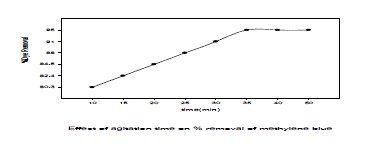 |
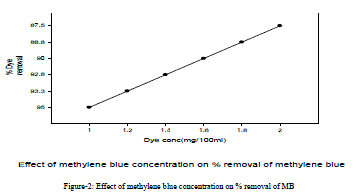 |
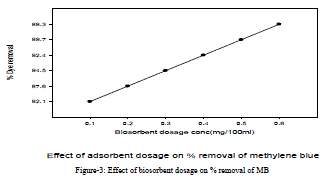 |
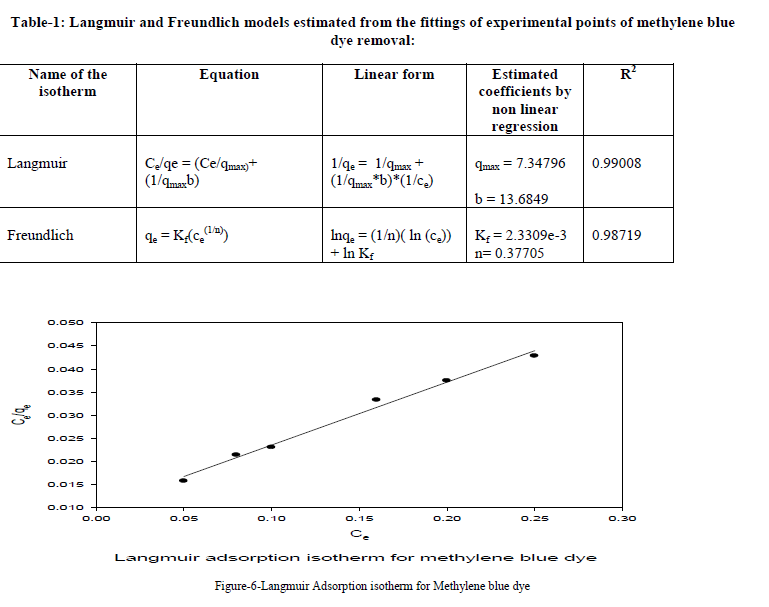 |
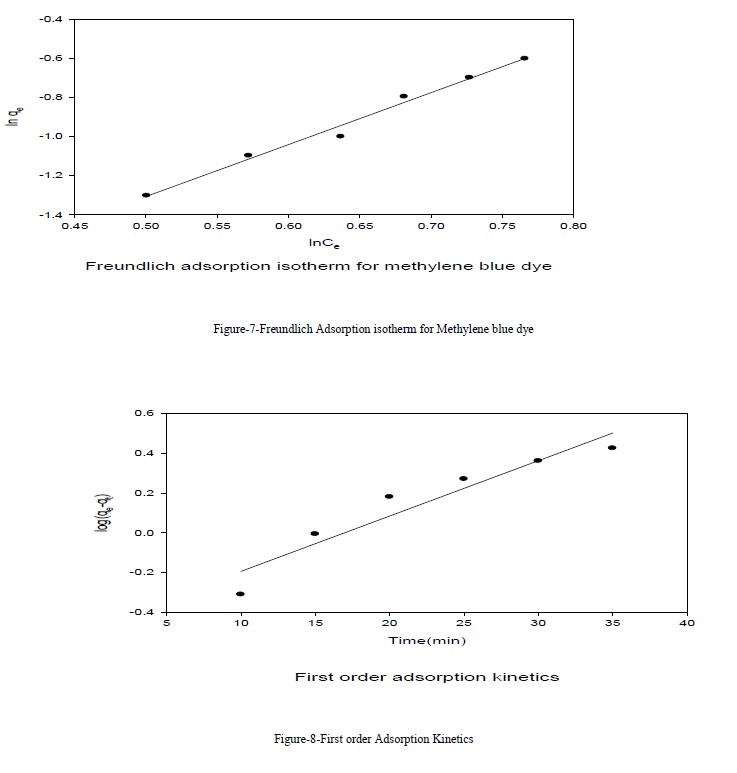 |
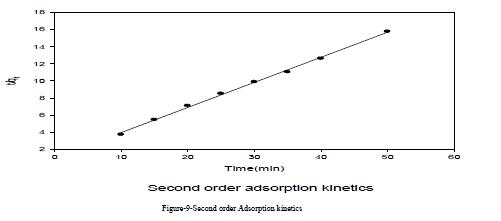 |
IV. CONCLUSION |
| The experimental results have shown that the Adsorption was an effective process of decolourization of textile waste waters and papaya peel (Adsorbent) is suitable for the sorption of Methylene blue. It is environmental friendly material. The Adsorption studies revealed that better dye removal performance was found to be effective for time of contact of 35 min, dye concentration of 1mg/100ml, adsorbent dosage of 0.3g/100ml, at pH 8 and at temperature 350 C. The sorption of methylene blue on papaya peel was found to follow Langmiuer- Freundlich isotherm, suggesting the possibility of heterogeneous distribution of active sites on the surface of the sorbent and second order kinetics is the best fit. The introduced adsorption system seems both very economical and efficient for the removal of cationic dyes such as methylene blue from aqueous solutions. The adsorbent introduced in this study seems to be very promising for application of waste water treatment in textile or other industries dealing with dyes and dyeing and this study confirmed that the biomaterial which is discarded as waste can be used as an efficient adsorbent for dye removal technology. |
References |
|